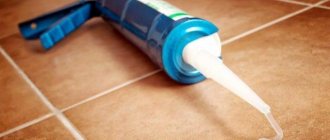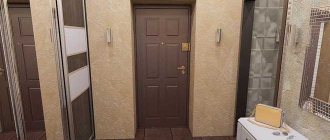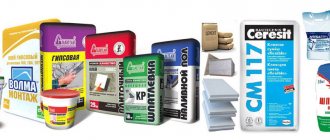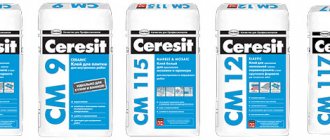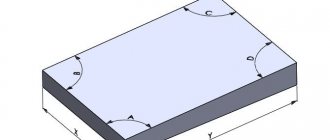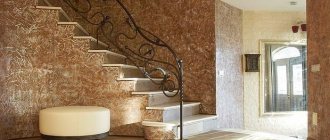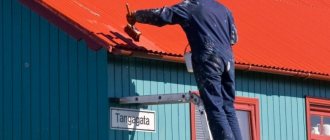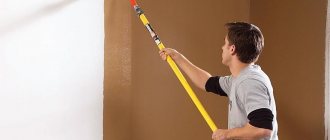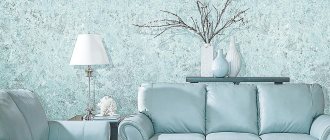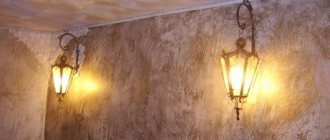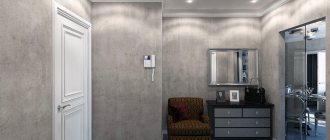To carry out finishing work in a house using decorative plaster, you should prepare the required amount of materials in advance. To do this, you need to find out how much material is required to perform a particular type of work. It is quite easy to make calculations if you know the required amount of decorative plaster per 1 m2.
Coverage area is always written on the package
Plaster calculation method
Typically, decorative mixtures are sold in packages that indicate the material consumption. The presented indicator is indicated in kilograms per 1 m2, or it indicates how much area one package of material will be enough for and what thickness of the layer should be. To calculate how much decorative plaster per 1 m2 of coating is required, you need to multiply the indicators by the desired thickness of the plaster coating layer.
Coverage area=(a+b)*H
How to reduce the consumption of decorative plasters
The prices for this material are not very high, but if you take into account the entire volume of necessary solutions and the cost of finishing work, you can get a fairly large amount. Therefore, it is recommended to follow simple rules that will help you save a little and reduce material consumption per m2:
- Use cheap cement-based mixtures for rough work.
- During the initial finishing, try to level the surface as much as possible so that the walls are covered no more than 5 mm.
- If the walls have significant curvature, it is more advisable to use plasterboard slabs to level the surface.
- Use primers that are recommended by plastering manufacturers, even if they are expensive.
Planning repair work is one of the most important stages of this event. A correctly calculated amount of material, as well as the selection of suitable consumables, will protect the customer from possible deception on the part of workers and the need to purchase additional solution during finishing.
Norm per 1m2 for different types of decorative plasters
The consumption rate of plaster coating when finishing the surface is the main indicator that is used to determine the required amount of material.
Different types of mixtures differ in these indicators; when choosing a decorative solution, you should carefully study the instructions and recommendations of the manufacturers.
Fur coat and other textured plasters
If the wall is covered with decorative material with a fur coat effect or other variants of textured mixtures, the amount of mortar per square meter will be 2 kg.
Bark beetle
When using bark beetle plaster coating, the solution consumption will be 3 kg/1 m2. In this case, a plaster layer 1 centimeter thick is taken into account.
Marble (with marble chips)
The amount of marble plaster coating required to finish 1 square meter of surface is 4 kilograms.
Sand
If interior wall decoration is done using sand plaster, the calculation uses a cost of 250 grams per 1 m2.
Moroccan or travertine
When using Moroccan mixture for interior decoration, you will need 2 kilograms of material per square meter of coating.
Venetian thin-layer plasters
An example of Venetian thin-layer plaster is one of the most economical materials. The mixture consumption in this case is only 140 grams per square meter.
Consumption table for different types of plasters
| Fur coat | Bark beetle | Marble | Sand | Moroccan | Venetian | |
| Consumption per 1m2 | 2kg | 3kg | 4kg | 250g | 2kg | 140g |
Calculation of plaster per m2: calculator and explanations
The first thing you need to find out is the area of the wall or ceiling (or any other surface intended for application. To do this, you need to measure the length and height of the wall (length and width of the ceiling) using a tape measure. Multiply the resulting numbers together. The result obtained in the future you you will multiply by the required plaster consumption (per 1 square meter) Thus, you can find out how much material is required in your case.
How to calculate plaster per m2 without a calculator? You need to know the required thickness of the final layer, the density of the material and the weight of one package. This will allow you to determine the volume of plaster required to process one square meter. Of course, it is much easier to use a wall plaster calculator by area because:
- You minimize the risk of making mistakes with calculations.
- You save a lot of time and complete the calculation in a matter of minutes.
- All you need to do is enter all the indicators in the special windows.
- You can quickly change key indicators and see how much it helps you save.
However, one cannot help but say that any plaster calculator makes calculations with some errors. you must understand that each effect is unique and will require a certain number of layers to create it. In other words, if you have not encountered this material before, then in the case of some complex effects it is better to seek advice from a specialist. The amount of materials suggested by the calculator may simply not be enough.
What does consumption depend on?
The consumption of decorative plaster per 1 m2 depends on a number of factors, the main ones are presented below:
- The composition of structural plaster directly affects consumption rates. You can find information about the features of the mixture on the manufacturer’s packaging.
- Thickness of the decorative coating layer.
- The volume of granules included in the composition. The larger the granules, the higher the solution consumption.
- Features of the surface being treated, the level of inclination, the presence of chips, cracks and other defects inside the walls.
- The type of substrate on which the solution will be applied also affects the amount of material required.
The presented factors are decisive when calculating the total volume of the mixture that will need to be purchased.
The amount of plaster will depend on the thickness of the applied layer
Textured solutions
Such mixtures are used to create coatings that imitate the texture of natural stone, leather, wood and other textures. This type of plaster boasts one of the lowest costs, which ranges from 0.9 to 1.5 kg per square meter. To calculate more accurately, you must first determine the grain size of the solution. If it contains fine components (about 1 mm), then the consumption will be minimal, since the thickness of the layer must correspond to the grain size in the mixture. If the grains reach 2-3 mm, then approximately 1.2 kg of textured mixture per square meter will be required. For coarse-grained materials, the consumption of decorative plaster increases to 1.5 kg.
Decorative plaster imitating the texture of wood, characterized by low material consumption
For example, we have a wall with an area of 10 square meters. m, which needs to be covered with a textured solution of medium dispersion in two layers. We multiply the size of the wall area by the material consumption, and then by the number of layers, we get: 10x1.2x2= 24 kg. This is exactly how much textured plaster will be needed to treat the surface of a given area.
Important! The thickness of the total textured layer should not exceed 1 cm, that is, if a material with coarse grains is used, then a maximum of two layers can be applied.
The thickness of the plaster layer directly depends on the source material
Calculations for different types of mixture
You can calculate the consumption of decorative plaster taking into account the characteristics of the compositions:
- textured;
- structural, etc.
The thickness of the layer and the volume of materials depend on the application technique (Venetian finishing, “bark beetle”, “fur coat”, mosaic, sand, travertine, silk, etc.).
Textured compositions
Textured plaster mixtures are used to create a relief coating (imitation of stone, wooden surfaces, geometric shapes, patterns, etc.). The consumption of solutions with fine granules up to 1 mm is no more than 900 g per 1 m². The indicator is due to the small thickness of the layer. If there are fractions up to 3 mm in the composition, the consumption of plaster will increase to 1.3 kg. Coarse plaster mixtures will require at least 1.6 kg per 1 m².
The calculations take into account the number of layers. In this case, the textured base should not be more than 10 mm thick. The volume of material required is influenced by the quality of the base leveling and the chosen application technique. For textured compositions, priming of surfaces is mandatory. It is optimal to use a special primer with quartz filler. Treating the wall will improve the quality of adhesion of the plaster to the base. The standard primer consumption will be up to 120-150 g per 1 m².
The use of protective varnish or wax must be taken into account when determining finishing costs. The material required is 100-130 g per 1 m² of coverage.
Structural plaster
Structural plaster compositions contain modeling components (natural or synthetic) that allow you to create a relief surface. On the base, you can reproduce contrasting inclusions, stripes horizontally or vertically when leveled using a trowel. The volume of plaster depends on the thickness of the filler.
The mixture consumption per 1 m² for interior decoration in 1 layer is as follows:
- Quartz chips - mixtures with fractions 1 mm thick will require 1 kg, 2 mm - 2 kg. If there are heterogeneous components up to 3 mm in the plaster composition, the material consumption will increase to 3.5 kg. For an area of 10 m² you will need 1-2 bags.
- Acrylic resin filler - the mass has a pasty consistency, suggesting increased consumption of material. The volume of the mixture used is 1.5 times the thickness of the fraction. For filler with 1 mm granules (Bayramix decorative plaster) the consumption will be 2.5 kg, 2 mm - 3.5 kg.
- Granite, malachite or marble chips - this composition is applied up to 3 mm thick. For every mm, up to 1 kg of plaster is required. Up to 3 kg of composition will be required per 1 m².
- Mixtures with acrylic filler are produced with granules measuring 0.4-2.5 mm. Material consumption per m² is, respectively, 1.5-3 kg. For 10 m² you will need 1-2 containers of product.
Venetian finish
Venetian plaster allows you to reproduce an imitation of marble, amber or malachite surface. The coatings last for more than 15 years, are environmentally friendly, aesthetic, and hypoallergenic. However, it is necessary to take into account the complex finishing technique.
The consumption of Venetian plaster will be 0.007-0.2 kg per 1 m², depending on the thickness of the layer. When using products with fine or coarse components to give the base an artificial aging effect, the volume of plaster used will be up to 2 kg.
Indicators are given for a single-layer coating. You can determine how much Venetian plaster is required depending on the number of layers. To give a rich shade, several coatings are needed, this will increase the consumption of the finishing mixture.
Before applying the plaster, you need to level the base using a primer with a coloring effect. The consumption of this material is on average 100-120 g per 1 m². For the final protective layer you will need wax at the rate of 80-90 g per 1 m².
Bark beetle
Bark beetle plaster allows you to reproduce grooves and artistic irregularities on the base. The work is carried out using gypsum or acrylic compounds. The volume of consumable materials is affected by the amount of water added when mixing the mixture and the size of the fractional components. The thickness of the coating must be at least 1 cm.
The amount of mass used also depends on its type and the manufacturer of the finishing composition:
- gypsum and acrylic products - 2.5-4 kg per 1 m² required;
- plaster of the “Volma” brand - when reproducing a “bark beetle” type surface, 6 kg/m² is consumed;
- composition "Ceresit" - required up to 3.8 kg/m²;
- plaster mixture of the “Starateli” brand has an increased consumption volume, up to 9 kg is used per 1 m²;
- Dufa plaster - up to 2.8 kg per 1 m².
These indicators are given for single-layer processing (1 cm). When finishing surfaces with plaster in several layers, its consumption will increase. Experts recommend purchasing products with a reserve of 9-10% of the main volume.
Consumption of Venetian plaster per meter. Classification
Based on the chemical composition, plasters (or liquid wallpaper) are distinguished, which are based on lime, acrylic or their dispersed compound.
In appearance, the Venetian can be of several types:
- smooth – made from marble dust and a binder;
- relief - a mass with a granular consistency used to form rough surfaces with the effect of aged marble;
- artistic – tinted plaster for textured painting.
The wax layer plays an important role in shaping the final appearance of the walls. It not only provides reliable protection, but also creates the effect of a specific marble surface. If desired, its shade can be matte, pearlescent, silver or golden.
What is Venetian plaster wallpaper?
Modern manufacturers offer an affordable finishing option that simplifies interior decoration. Vinyl wallpaper perfectly imitates the texture and colors of Venetian plaster. In addition, they are widespread and affordable.
The basis of the wallpaper is a thick layer of paper. Wall pasting is carried out in the traditional way using special glue.
Consumption
Preliminary calculation helps determine the required amount of finishing materials, as well as avoid unnecessary costs. The final consumption of plaster depends on the curvature of the walls and the type of base.
As an example, consider the Venetian cladding of a plot of 10 sq.m. It shows the deviation of the surface vertically and horizontally in three places by 10, 30 and 50 mm, respectively.
1. Determine the average thickness of the plaster layer: (10+30+50)/3=30 mm.
2. Find out the total mass of the required solution. From the instructions on the packaging we find out the recommended consumption of the Venetian mixture per 1 m2 with a layer thickness of 10 mm. Typically it ranges from 0.7 to 2 kg.
- 1 kg × 3 cm × 10 sq.m = 30 kg – total weight.
3. We calculate the number of bags, taking into account that the standard packaging is 15 or 30 kg.
How to reduce costs?
Decorative materials are quite expensive. But if you use useful tips, you can significantly reduce upcoming financial costs:
- Before finishing work, the walls are leveled using affordable cement-based mixtures;
- before applying decorative plaster, putty is used to smooth out defective areas;
- if the differences exceed five centimeters, the wall should be covered with plasterboard sheets;
- the surface is pre-primed with a deep penetration compound recommended for use by the manufacturer of the plaster mixture;
- select formulations with a lower declared consumption value;
- Take wall measurements as accurately as possible;
- When purchasing material, check the package weight. There is a possibility that the plaster is packaged in optimal portions.
When mixing the plaster mixture, you should not change the ratio of components - act strictly according to the instructions from the manufacturer. Your rash actions will lead to a decrease in the technical performance of the mixture, the speed of its hardening and aesthetics.
In addition, the service life of the decorative layer will be reduced, which will especially affect additional costs in the future.
How to calculate plaster consumption
Experts suggest using two ways to calculate needs:
First: to calculate the required amount of plaster that will be needed to perform repair or basic finishing work, the following are used:
- the area of all walls to be repaired in each room;
- data on the curvature of each wall;
- information on the yield of the solution of the finished mixture, which is obtained by diluting with water;
- a burden that will additionally fall on the walls.
The thickness of the plaster should be no more than 4 cm.
Data on the first two indicators are of great importance, because many compositions cannot be laid in one layer. The maximum permissible thickness is 3-4 cm. If there is a need to use a thicker layer, the wall is pre-reinforced using a special metal or fiberglass mesh. With this preparation, the thickness of the applied layer can be 5-7 cm.
When calculating the need for the finished solution, it should be borne in mind that in the instructions that are attached, all calculations are based on the thickness of 1 mm of the applied layer. Therefore, knowing how many square meters of space one package is designed for, it is easy to calculate its actual need. To determine the need for a dry mixture, use the following formula:
In addition, one should take into account such an indicator as the weight of plaster per 1 sq.m. For example, the weight of certain types of plaster reaches from 8 to 10 kg per square meter, and if the thickness of the layer increases several times, the weight of the plaster increases accordingly.
Second: the instructions contain data on the amount of the finished mixture that will be obtained when diluting the dry composition, as well as the amount of water required for this.
We need to calculate the amount of dry mixture. For this:
- we calculate the area of the working surface that is to be covered with the solution, multiply it by the average thickness of the plaster, as well as the consumption coefficient of the finished mixture;
- we multiply the obtained result by the amount of water recommended by the manufacturer of the dry mixture that is necessary to prepare the solution;
- From the amount of solution that came out, we subtract the amount of water needed for a given volume of solution.
Plaster Knauf Rotband
Knauf Rotband is very popular among craftsmen and finishers. Firstly, because of its versatility (suitable for concrete, brick, cement surfaces, as well as gypsum partitions). Secondly, because of its affordable price.
When purchasing Knauf-Rotband plaster, you should not pay attention to its color, since similar products can be white, gray or pink. Different colors and shades of the mixture are given by polymer additives, which are mixed with the main ingredients specifically to give good stickiness to the finished solution.
The consumption of Rotband is much less than cement-based solutions, since gypsum predominates in these products. 8.5 kg of mixture is enough to cover an area of 1 mm2. A layer 1 cm thick dries in no more than 1 hour, but to fully gain strength, the plaster should be allowed to sit for at least 7 days.
Gypsum solutions are capricious in some nuances, so Rotband has several minor drawbacks:
- A layer of Rotband plaster is inferior in strength to the same layer, but based on a cement component.
- It quickly enters into a process with metal parts (nails, screws, screws, self-tapping screws), which leads to their rust. Therefore, yellow stains may appear on the plastered surface over time.
- It is best not to apply Rotband in areas with high humidity.
Important! The building materials market is filled with fakes, which in appearance and cost are practically no different from the original. The main feature of Knauf Rotband unnatural plaster is the presence of sand in the packaging. Such a product should be returned to the seller immediately!
Flow calculation
Then you can continue the calculations to determine how much solution is needed. For example, decorative bark beetle plaster was chosen to decorate the wall. According to the manufacturer’s recommendations, to treat 1 m2 with a one-centimeter layer, 3 kilograms of the mixture are needed.
So, we will need to apply a layer of 3 cm, and for this we need to multiply 3 kilograms by 3. As a result, we will get 9 kilograms of the required solution. As a result, to treat a wall with an area of 1 m2 you need 9 kg of solution. But to finish a surface of 10 m2, you will need to multiply 10 m2 by 9 kg. After calculations we get a result of 90 kg.
Let's assume that our plaster is packaged in 30kg bags. Now let's find out how many bags are needed for complete lining. It will take 90 kg divided by 30 kg, and as a result we will get exactly three bags. We recommend buying with a reserve and purchasing four bags just in case.
As you can see, the calculation method is quite simple. With this, you can easily determine how much finishing will be needed to cover the wall to create a decorative effect. Even if you hired a construction crew for the job, this will help control the material consumption.
Important Rules
Before moving on to calculations, determine the area of the walls to be repaired. To this end, check their length and height parameters in increments of one meter to eliminate possible unevenness. If you are going to finish in fragments, take into account only the areas intended for processing, determine the area of each, and add up all the values.
To find the total area, multiply the length by the height.
The plaster consumption is determined by multiplying the area of the wall surface being repaired by the norm for a meter area indicated by the manufacturer on the packaging container. If a thick layer is to be applied, additional calculation steps are performed.
A ten percent supply of material is added to the final data, taking into account possible losses.
So, to perform the calculations you need to clarify:
- surface parameters;
- the height of the mortar layer to be applied;
- type and brand of solution;
- mass of material in one package.
For the convenience of performing calculations, it is recommended to use an online calculator by entering known data into the appropriate columns.
